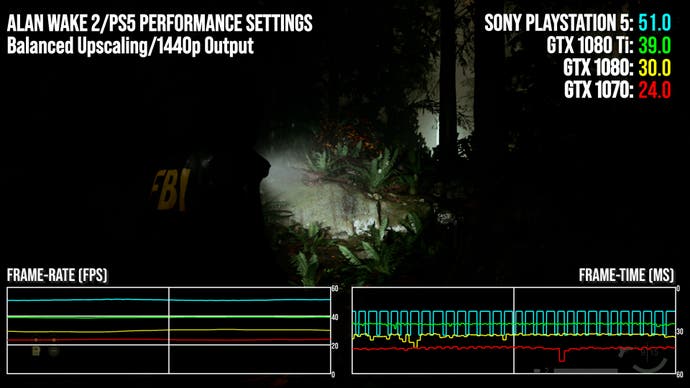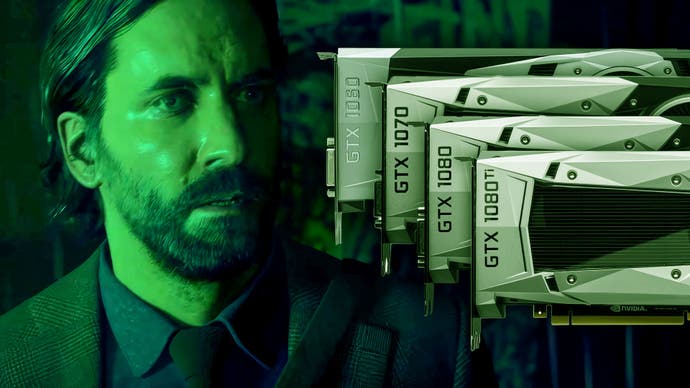Upcoming Alan Wake 2 patch drastically improves GTX 10-series performance
A look at the new optimisations, plus general PC improvements since launch.
Alan Wake 2 was one of the most visually stunning games of 2023 - but also one of the most demanding for older hardware. Owing to its use of DX12 Ultimate mesh shaders, the game could run on older hardware but often delivered an unplayable experience, especially on Nvidia's GTX 10-series GPUs built on the Pascal architecture. This is an issue because so many of them are still in use: around nine percent of the Steam Hardware Survey's GPUs are 10-series cards. Last week, Remedy approached us with the chance to preview a PC patch going live on March 6th, which radically improves matters for Pascal users. At the same time, it's a golden opportunity for us to revisit Remedy's other work on the game since launch.
Nvidia's GTX 1060 remains one of the oldest and popular GPUs still in use, so it's a good initial focus for this piece. Its lack of mesh shader support is its undoing in Alan Wake 2. Mesh shaders give developers greater control over how much geometry is rendered on screen at any given moment, potentially allowing for much greater level of detail. Alan Wake 2 is a mesh shading showcase, with some incredible, highly detailed assets that look great viewed from far away or in extreme close-up.
The game does function on GPUs that don't support mesh shaders, but poor performance and visual errors are the problem: the GTX 1060 at 1080p on FSR 2 quality mode, married up with PS5's performance mode quality presets delivers a game typically running under 60fps, more usually hitting circa 15fps. Game frame-rate is so low, even game speed and audio playback are compromised.
In a run through the forest in the first chapter, the upcoming patch increased performance by an impressive 45 percent - an impressive boost bearing in mind the lack of mesh shader hardware support. Pascal GPUs actually fared even worse in Saga Anderson's Mind Place and with the new patch, there's an almost 3x performance multiplier. Curiously, as you move up the Pascal stack of GPUs, the performance increases with the new patch rise still further. The same tests on GTX 1070 delivered a 57 percent increase in the forest, rising to 85 percent with the GTX 1080. Moving up to the now legendary GTX 1080 Ti (still a reasonably powerful GPU today), performance effectively doubles. At 1080p, the 1080 Ti is now delivering a good VRR experience on 60Hz panels. It's a game transformed.
Next up, I wanted to see if there's a baseline card from the 10-series range I could recommend for Alan Wake 2 - and bearing in mind how popular it is, the GTX 1060 was my first port of call. Unfortunately, I quickly discovered that no level of resolution reduction could help us attain a circa 30fps experience. Even at very low resolutions like 720p, sub-720p or even Super Nintendo-level resolutions like FSR 2 ultra performance mode, it was easy to see obvious frame-time spikes and drops below 30fps. Even at ridiculously low resolutions where the GPU realistically should not be limited by pixel shader throughput, the GTX 1060 had issues. Here, I imagine some other aspect of the GPU is causing issues, preventing even performance.
So, based on our testing, I would say that the base Pascal GPU that can play Alan Wake 2 respectably is the GTX 1070, which can do a good 30fps on the low settings, or the PS5's performance mode-equivalent settings (effectively low with medium ground detail). Other higher-end Pascal generation GPUs can manage much more and there's grounds for optimism that the GTX 1080 Ti in particular could deliver a PS5-style upscaled 1440p experience on equivalent performance mode settings. We tested this in a demanding area found in chapter two, where the PS5 struggles in both its quality and performance modes. The GTX 1070 struggles at circa 24fps, but the GTX 1080 hits 30fps while GTX 1080 Ti could possibly lock to 40fps for much of the game.
It's impressive to see compared to prior results, but it's worth noting that more modern GPUs with mesh shader support still do a lot better. In our PS5-based stress test, for example, the RTX 3060 outscores the GTX 1080 Ti by around 22 percent, rising to 35 percent with 2070 Super and 37 percent from the recent RTX 4060. In theory, the GTX 1080 Ti should be beating those cards or delivering broad parity with RTX 4060 or RTX 2070 Super - and yet, hardware-based mesh shader support is seeing them leave GTX 1080 Ti for dust. The patch works wonders for Pascal GPUs, but it only goes so far.
It's also fair to say that the patch is only going to benefit 10-series users. The RX 580 was the GTX 1060's nemesis back in the day, but Alan Wake 2 still has big performance problems and crashing issues. It doesn't help that AMD itself has given up on driver support for both Polaris and Vega architectures. RDNA 1 cards such as the RX 5700 and RX 5700 XT show small improvements since launch, but likely not down to this patch in particular but more through general optimisations over time. General performance is OK though - much better than Pascal - though frame-time irregularities are problematic. I would say that RDNA 1 still needs more work, but it is definitely a question of return on investment for Remedy: there are few RDNA 1 cards out there in comparison to RTX or GTX cards, so perhaps the engineering time is not worth it, even if I would like to see it worked on.
What you might call 'organic' optimisations over time have seen some nice improvements for modern GPUs, however. I compared new data to legacy captures from the launch period, starting with the RTX 3070 where I didn't notice much difference in rasterised performance. However, RTX 40-series cards have benefited, where I noted a 14 percent improvement in rasterisation and a six percent uplift with path tracing. Perhaps this is down to driver optimisations in the meantime, improvements from Remedy or a combination, but whichever way you slice it, it's good to see these boosts on such a demanding title.


There are other non-performance based improvements added since launch too, such as a much more meaningful graphics options screen, which includes more detail on what the various settings do, along with very helpful preview images. On top of that, changes to settings occur in real-time (gameplay is visible behind the menu), so with a performance overlay, you instantly see changes in frame-rate based on your settings tweakery. And praise be for a menu system that allows you to make as many changes as you want without the need to restart the game. That said, I would like to see half, third and quarter v-sync options, which would really help out for 30fps and 40fps caps without the need to use tools like Kaldaien's SpecialK.
Other improvements I'd like to see would include AMD FSR 3 frame generation without the need for modding the existing DLSS 3 solution, plus a fix for the lengthy freeze in the path-traced version when exiting a video sequence. Curiously, the intro video sequence now exhibits inconsistent frame-pacing in playback - unlike the launch version - so I'd like to see that fixed too.
Other than those issues, it's fair to say that Alan Wake is in a great place now for PC users and I'm really happy that Remedy gave us this preview code to check out. The launch version was fine but this is even better, while the enhancements for Nvidia's 10-series GPUs are welcome. While the GTX 1060 is still being pushed too far, anything from a GTX 1070 upwards can deliver a playable, consistently smooth experience. A highly demanding game now runs well on the most popular 2016-level Nvidia hardware - that's quite the achievement from Remedy, so do consider checking it out if you're still using older kit.










